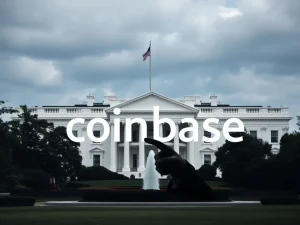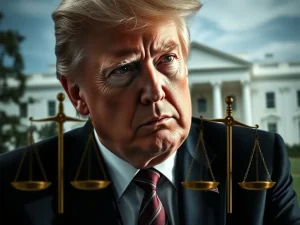US-EU Trade Deal: A Historic $600 Billion Investment Secures Global Economic Stability

While the cryptocurrency market often dances to its own unique rhythm, it’s intrinsically linked to the broader global economic landscape. A recent landmark development, the US-EU Trade Deal, has sent ripples across traditional financial markets, potentially impacting everything from commodity prices to investor sentiment. This agreement, designed to avert a full-blown transatlantic trade war, carries significant weight for global economy stability, a factor that can indirectly influence the digital asset space. Understanding these macroeconomic shifts is crucial for any informed market participant.
Unpacking the Landmark US-EU Trade Deal: What Does It Entail?
On July 25, 2025, the Trump administration and the European Union announced a significant trade agreement, a culmination of weeks of intense negotiations. This pact is designed to rebalance economic ties and prevent a potentially damaging transatlantic trade war. The core components of this agreement are twofold:
- 15% Baseline Tariff: A 15% tariff will be applied to most European goods entering the U.S., particularly industrial and manufacturing products. This was a central demand from the U.S. side, aimed at addressing perceived trade imbalances.
- $600 Billion Investment Pledge: In a reciprocal move, the EU has committed to investing a substantial $600 billion into the American economy. This investment is earmarked for key sectors such as infrastructure, technology, and energy, with the potential to stimulate job creation and enhance supply chain resilience in the U.S.
Beyond these core elements, the EU also committed to purchasing $750 billion in U.S. energy exports, including liquefied natural gas and refined fuels, and additional military equipment over the coming years. This comprehensive approach replaces earlier threats of unilateral tariffs with a structured framework for long-term cooperation.
Averting Conflict: The Core of the Tariff Agreement
The immediate impact of this agreement is the successful avoidance of a major trade war between two of the world’s largest economic blocs. The Tariff Agreement represents a strategic compromise, balancing the U.S. administration’s demand for protection for domestic sectors with the need to maintain robust trade flows. Unlike previous unilateral actions, this deal incorporates reciprocal measures, which analysts describe as a “give-and-take” mechanism. This approach aims to offset the financial burden on European industries by providing them with opportunities for investment and procurement within the U.S. European Commission President Ursula von der Leyen highlighted the deal as a “bridge to a more balanced future,” signifying the EU’s strategic alignment with U.S. energy and defense priorities.
Boosting the Global Economy: Investment and Energy Commitments
The promised $600 billion investment from European firms into the U.S. economy is a cornerstone of this deal. This capital infusion is expected to target critical sectors, fostering innovation and infrastructure modernization. Here’s how it aims to boost the global economy:
- Job Creation: European firms expanding manufacturing and R&D operations in the U.S. could lead to significant job growth.
- Supply Chain Resilience: Increased domestic production and investment can strengthen supply chains, making them less vulnerable to disruptions.
- Technological Advancement: Investment in technology sectors can accelerate innovation and maintain U.S. competitiveness in global markets.
- Energy Security: The EU’s commitment to purchasing U.S. energy exports helps reduce Europe’s reliance on other sources, aligning with broader geopolitical goals and strengthening energy security.
These economic ripple effects are not confined to the U.S. and EU; a stable and growing transatlantic economic relationship can provide a crucial anchor for global trade and investment, benefiting other regions indirectly.
Strengthening Transatlantic Relations: Beyond Just Trade
This agreement is more than just an economic pact; it signals a significant strengthening of Transatlantic Relations. The commitment to U.S. energy and military equipment procurement aligns with broader geopolitical objectives, including bolstering NATO cohesion and reducing European reliance on geopolitical rivals. This strategic alignment underscores a renewed commitment to cooperation on issues beyond purely economic ones, potentially leading to greater stability in international affairs. For cryptocurrency enthusiasts, a more stable global political and economic environment can foster greater confidence in traditional markets, which often correlates with broader investment appetite, including for digital assets.
Navigating the Future: Can This Deal Ensure Economic Stability?
While the deal is hailed as a victory for diplomatic efforts, it has not been without its critics. Some experts warn that the 15% tariffs could still distort global supply chains and potentially raise consumer prices, particularly for luxury goods and automobiles imported from Europe. Within the EU, industries heavily reliant on U.S. imports have expressed concerns over the impact on their costs and competitiveness. On the U.S. side, questions have been raised about the enforceability of the EU’s investment and energy export targets.
Despite these hurdles, the pact marks a significant shift from previous confrontational trade approaches, offering a model for transatlantic collaboration amid global economic uncertainties. The ultimate success of this agreement will depend on its implementation, requiring both sides to navigate regulatory challenges and domestic political resistance. If successful, it could indeed pave the way for long-term economic stability, providing a more predictable environment for businesses and investors worldwide, including those in the burgeoning digital asset space.
This landmark agreement underscores the intricate web of global economics and politics. While its direct impact on cryptocurrency markets might not be immediate or obvious, the broader implications for global trade, investment, and geopolitical stability are undeniable. A more predictable and cooperative international trade environment generally fosters greater confidence, which can indirectly support growth across all asset classes, including digital currencies. As the world navigates complex economic currents, this US-EU deal stands as a testament to the power of diplomacy in averting conflict and fostering a more integrated global future.
Frequently Asked Questions (FAQs)
Q1: What is the primary purpose of the US-EU Trade Deal?
The primary purpose of the US-EU Trade Deal is to avert a potential transatlantic trade war, rebalance economic ties between the two regions, and foster long-term cooperation through a structured framework of tariffs, investments, and procurement commitments.
Q2: What are the key financial components of the Tariff Agreement?
The key financial components include a 15% baseline tariff on most European goods entering the U.S., a $600 billion investment pledge from the EU into the American economy, and a commitment from the EU to purchase $750 billion in U.S. energy exports and military equipment.
Q3: How might this deal impact the Global Economy?
This deal aims to boost the global economy by stimulating U.S. infrastructure, technology, and energy sectors through EU investment, potentially creating jobs and enhancing supply chain resilience. It also strengthens energy security and overall market stability by fostering cooperation between two major economic blocs.
Q4: What are the main criticisms or challenges associated with the US-EU Trade Deal?
Critics warn that the 15% tariffs could distort global supply chains and potentially raise consumer prices. Concerns also exist within the EU regarding the impact on industry costs and competitiveness, while on the U.S. side, questions have been raised about the enforceability and effective deployment of the EU’s investment and export targets.
Q5: How does this deal strengthen Transatlantic Relations?
Beyond trade, the deal strengthens Transatlantic Relations by aligning the EU with U.S. energy and defense priorities, including reducing Europe’s reliance on Russian energy and bolstering NATO cohesion. This signifies a renewed commitment to broader geopolitical cooperation.








